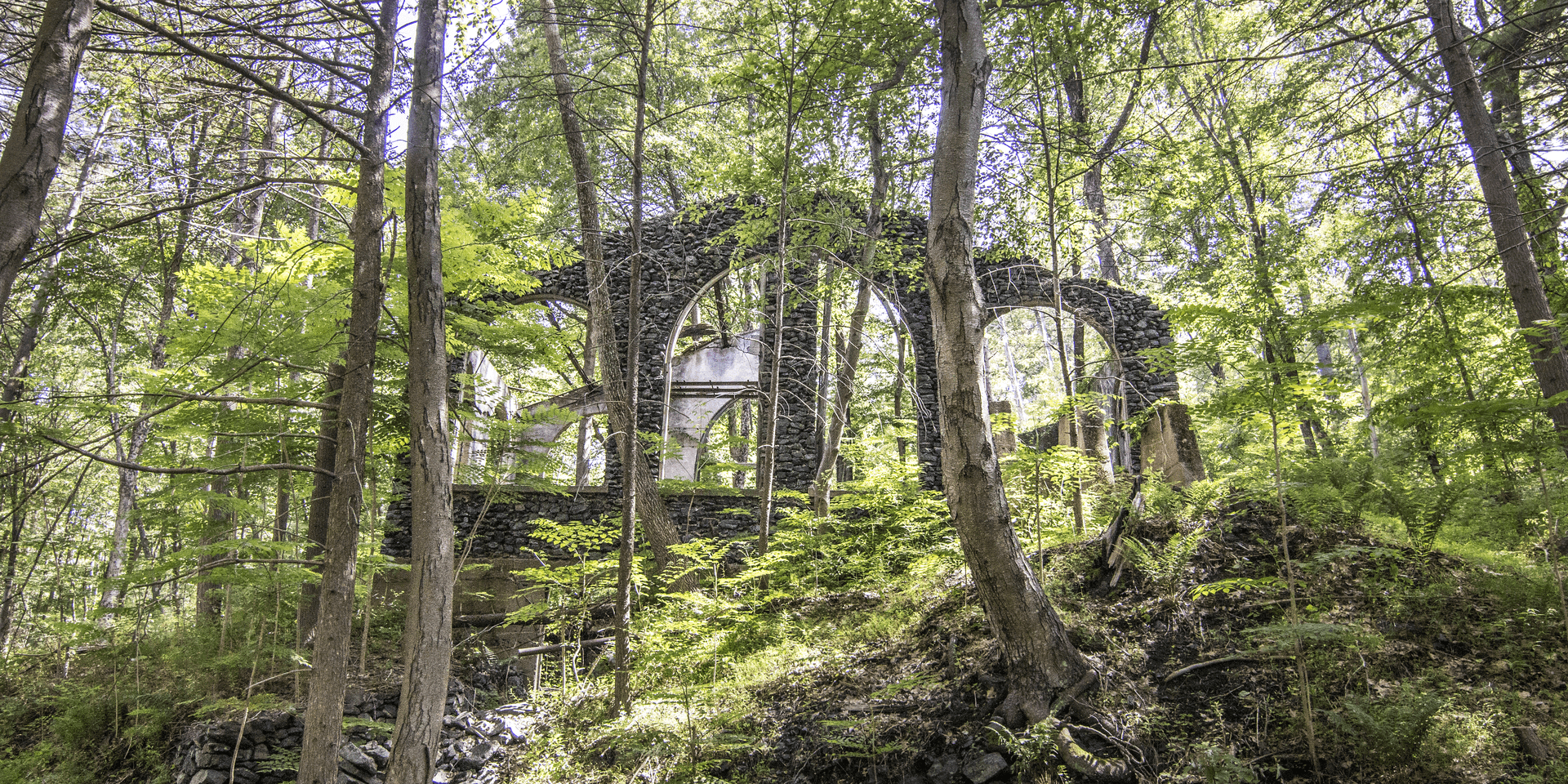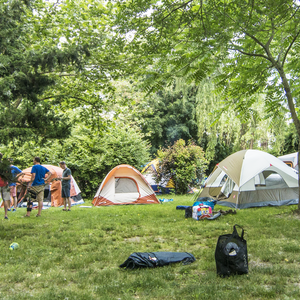You are here
Sterling Forest State Park spans almost 22,000-acres and is located about 40-miles northwest of New York City. The park, established in 1998, is in Orange County and includes the Ramapo Mountains in the New York and New Jersey Highlands. The land at the southern end of Sterling Lake was once owned by Sterling Iron Works and home to the bustling mine town of Lakeville. This entire area is rich with a unique history that dates back to the British Colonies and the foundation of America. There is an incredible 1.25-mile exploratory trail that leads though old ruins and relics from these former times. This preserved cluster of facilities provides a visual reconstruction of the steps that were once used to manufacture crude ore into goods and war materials for the entire northeastern United States from 1761 to 1842. The New York State Office of Parks, Recreation and Historic Preservation (NYS OPRHP) has a published map to help you navigate your route.
Experiencing the Ironworks Trail
Begin at the Senator Frank R. Lautenberg Visitor Center which overlooks Sterling Lake, which is open every day from 8:00 a.m. to 4:30 p.m. You can pick up a brochure inside that will help guide you through the trail and provide you with more details about each of the sights along the way. The Sterling Iron Works company was named in honor of the land’s owner, William Alexander, who was an American General of the Revolutionary Army and financier of the Patriot cause. The surrounding town and community of Lakeville grew up around these facilities to house miners and their families. It once had over 500 residents; however, it was abandoned when operations ceased in the early 20th century.
Follow the blue-blazes that lead to the left of the information center’s entrance. Your first stop is the foundation of a Methodist Church that once served many of the residents. From here, a bumpy dirt path laden with tree roots will bring you through a wooded area and emerge at a sign labeled The Lakeville Ironworks Trail. Take a left and follow the yellow-blazes for the remainder of the trail. This is the point that the trail will rejoin.
Proceed down the hill toward Sterling Furnace No. 2. A plaque will be on your left commemorating the production of the great chain that spanned several sections of the Hudson River around West Point to prevent British militias from navigating up the river. Ship anchors were also manufactured here, including one for the USS Constitution, the oldest commissioned naval vessel afloat, which is is now on display in the Boston Harbor.
Continue to the grassy area in front of the furnace and next to the road. Raw, concentrated iron ore was smelted here with charcoal and limestone and poured into forms to be converted to ingots. While ore came from the mine, the limestone came from a nearby quarry in Monroe, and the surrounding forest was stripped and converted to charcoal for fuel. Water from the outfall of the lake powered the machinery and large bellows that would force air into the furnace to raise the temperature to iron melt point. In addition to war materials, farm equipment was also produced here. Following the closing of the mine, the structure deteriorated to a pile of rubble until a restoration took place in 1960 by architect Roland Robbins. The wooden, neo-classical columns were erected around the furnace to protect it, and they originally had a dome over the top.
Follow the markers across the road to the last remaining Lakeville house. When the community was first formed around the mine, the workmen lived rent free. However, this changed in the 1870s when the Sterling Iron and Railway Company began renting the houses to the miners. Some of the other homes were moved to the surrounding communities when the town was shut down.
Continue across a footbridge back over Old Forge Road. Proceed up the hill through a wooded area covered with pine needles. You will pass the remains of the Cold Shire Surface Mine, where there is a sign that describes the ecological impact of mining. At Lakeville, mining adversely affected the quality of water, air, and soil. Today, the tailings from the mines here have high levels of aluminum, chromium, nickel, and elevated levels of a stable form of strontium. Despite these pollutants, water tests indicate the area is much cleaner than many similar mines.
Sterling Mine was initially a surface mine responsible for the surrounding depressions in rock formations and alteration of the terrain. Continue past the remains of other mining related structures until you reach the cluster of deteriorated buildings with a sign that reads “Mining at Sterling Lake.” At first the ore was so rich that it could be shipped without any additional processing. Once this was removed, operations greatly diminished until 1918 when the Ramapo Ore Company (ROC) signed a 50-year lease to operate the iron mines and installed a separating mill and dryer to convert the remaining material into a useful substance. However, ROC went out of business by 1923.
The large stone building in front of you once housed the cable mechanism that hauled ore cars from the mine beneath the lake. The ore was dumped onto conveyors that moved the ore to the crusher and dryer that are visible through the trees next to the road.
Proceed down the hill to another information sign and a walking bridge located next to the now flooded mineshaft. These two shafts extended deep below Sterling Lake, and the sign displays more about these excavations. The rails for hauling the ore carts can still be seen emerging from the holes. At the time it closed, the mine’s main shaft was two-thirds of a mile long and extended 1,100 vertical feet below the lake’s surface! While it is impossible to tell from the small entrance at the surface, the shaft runs downward at an angle between 12 and 25 degrees and is over 1,000 feet wide in some places! Workers removed more than 2.5 billion pounds of high-grade iron ore from the mine between 1843 and 1923, and upon the mine’s closing, it was filled with water.
Depart from the woods and onto West Lake road, where blue-blazes lead to the right. There are building remains that once served as the concentrating mill where large magnets were used to separate the ore. It was then placed in storage bins and loaded onto the Sterling Mountain Railroad.
Follow the road until the trail turns left up a small hill back into the forest. There is a view of Sterling Lake and a footbridge over a sluice that channeled water through a waterwheel to operate the large restored furnace, one of three that were originally built. Complete the loop upon returning to the trail intersection with the yellow-blazes. Return on the same wooded path back to the information center.
Sterling Forest State Park
At one time, the Sterling Forest Corporation was planning to build 13,000 homes, a golf course, and a series of industrial and commercial developments. However, the Trust for Public Land and the Open Space Institute were able to raise the seller’s $55 million asking price, $17.5 million of which was approved by the senate parks bill in 1996. Today the land serves as an important habitat for many species of resident and migrating birds as well as timber rattlesnakes, fox, and black bear. Hunting is permitted in specific areas during deer and turkey season with a New York State hunting license and a park permit. Dogs are allowed, but they must be on a leash not more than 6-feet in length. You can learn more about the forest and its history at the Frank R. Lautenberg Visitor Center: The center features a number of exhibits including models of the Lakeville mining town, live reptiles and amphibians of the region, and a large topographical map of the entire forest with LEDs that light up the respective trails with a push of a button.
This adventure can be combined with a trek to the Sterling Mountain Fire Observation Tower and Observer’s Cabin, a 4-mile, 660-foot ascent, there-and-back trail that begins a short distance from these mine ruins. The New York State Office of Parks, Recreation and Historic Preservation (NYS OPRHP) has a published map to help you navigate your route.
Logistics + Planning
Current Weather: Powered by Dark Sky


































Comments
Sign In and share them.